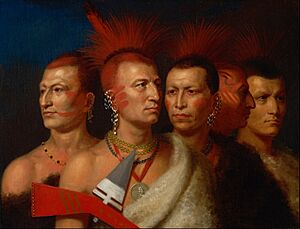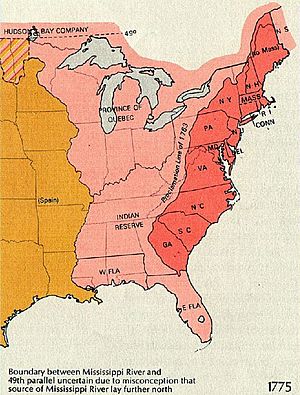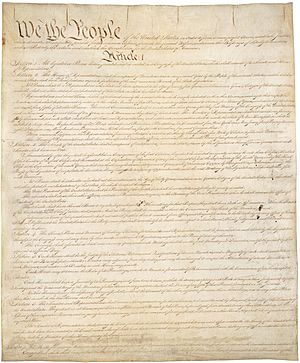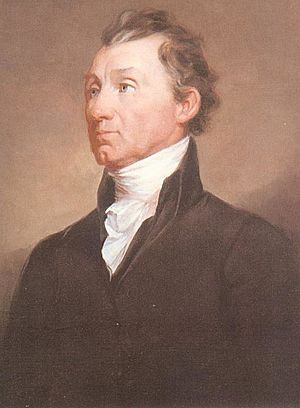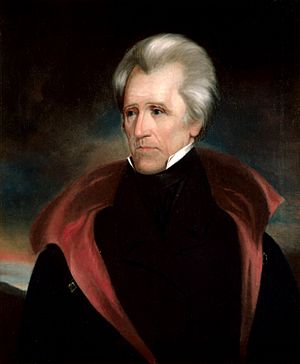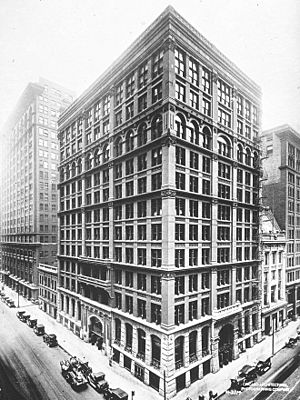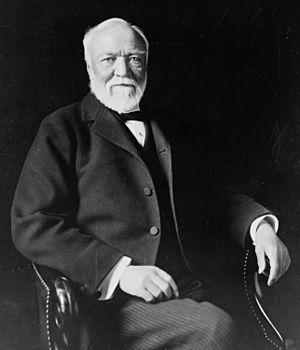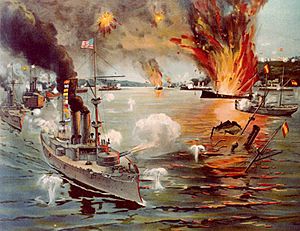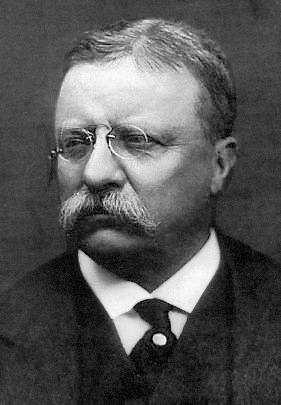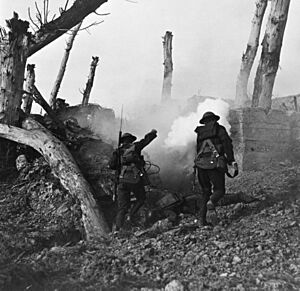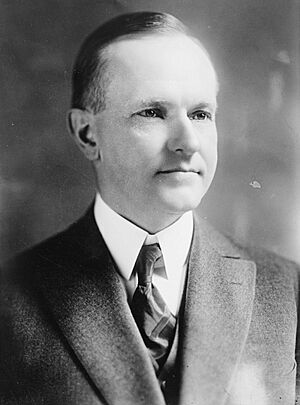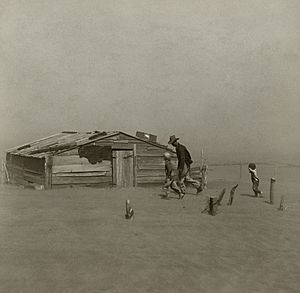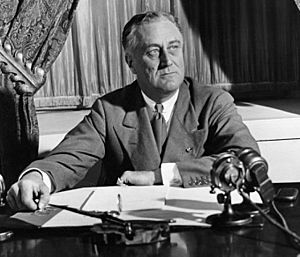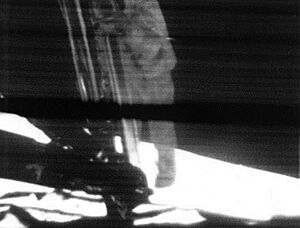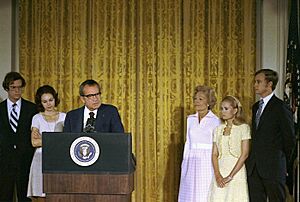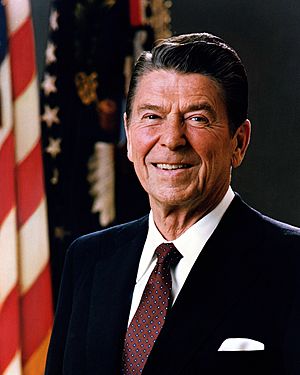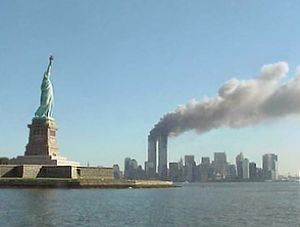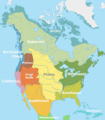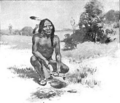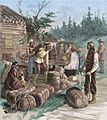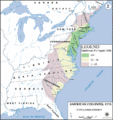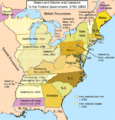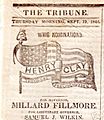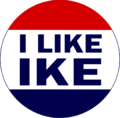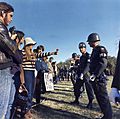History of the United States facts for kids
The history of the United States tells the story of what happened in the past in the United States. This country is located in North America.
For thousands of years, Native Americans lived in the Americas. In 1607, English people arrived in a place now called Jamestown, Virginia. Other European settlers came to the colonies, mostly from England and later Great Britain. France, Spain, and the Netherlands also started colonies in North America. In 1775, a war began between the thirteen colonies and Britain. The colonists were unhappy about paying taxes to the British government without having a say in how that money was spent.
The war, known as the Revolutionary War, started on April 19, 1775. On July 4, 1776, important leaders called the Founding Fathers wrote the United States Declaration of Independence. The colonists won the war and created a new country. They signed the Constitution in 1787 and the Bill of Rights in 1791. General George Washington, who led the army, became the first president. During the 1800s, the United States gained much more land in the West. It also started to become industrialized, meaning more factories were built. In 1861, several states in the South tried to leave the United States to form a new country called the Confederate States of America. This led to the American Civil War. After the war, many people immigrated to the U.S. Some Americans became very rich during this time, known as the Gilded Age. The country developed one of the largest economies in the world.
In the early 1900s, the United States became a world power. It fought in World War I and World War II. Between these wars, there was a time of economic growth called the Roaring Twenties. Many people became richer. Then came a time of economic hardship called the Great Depression, when most people became poorer. The Great Depression ended with World War II.
After World War II, the United States and the Soviet Union entered the Cold War. This included wars in Korea and Vietnam. During this period, African-Americans, Chicanos, and women worked hard to gain more rights. In the 1970s and 1980s, the United States started to produce fewer goods in factories. The country then faced a difficult economic time. In the late 1980s, the Cold War ended, which helped the U.S. economy. The Middle East became more important in American foreign policy, especially after the September 11 attacks in 2001.
Contents
- Early America: Before Columbus
- Colonial America: New Settlements
- American Revolution: Fighting for Freedom
- The Early Republic: Building a Nation (1781–1815)
- Growth and Change: Expansion, Industry, and Slavery (1815–1861)
- Civil War: A Nation Divided
- Reconstruction and the Gilded Age: Rebuilding and Riches
- Progressive Era and Imperialism: Change and Global Reach
- World War I: Global Conflict (1914–1918)
- Boom and Bust: The 1920s and Great Depression (1919–1939)
- World War II: A Global Fight (1939–1945)
- Postwar Era: Cold War and Social Change (1945–1991)
- Modern America: Post-Cold War and Beyond (1991–Present)
- Related pages
- Images for kids
- See also
Early America: Before Columbus
The time before Christopher Columbus arrived in the Americas in 1492 is called the Pre-Columbian Era. During this time, Native Americans lived on the land that is now the United States. They had many different cultures. For example, Native Americans in the Eastern Woodlands hunted animals like deer. Those in the Northwest fished. Native Americans in the Southwest grew corn and built houses called pueblos. People in the Great Plains hunted Bison. Around the year 1000, Vikings visited Newfoundland, but they did not stay and settle there.
Colonial America: New Settlements
The English first tried to settle at Roanoke Island in 1585. This settlement did not last, and no one knows what happened to the people. In 1607, the first lasting English settlement was made at Jamestown, Virginia. John Smith, John Rolfe, and other Englishmen came looking for gold and adventure. In its early years, many people in Virginia died from disease and starvation. The Virginia colony survived because it made money by growing tobacco.
In 1621, a group of Englishmen called the Pilgrims settled at Plymouth, Massachusetts. A larger colony was built at Massachusetts Bay by the Puritans in 1630. The Pilgrims and Puritans wanted to create a better society, not just find gold. They called this ideal society a "city on a hill." A man named Roger Williams left Massachusetts after disagreeing with the Puritans. He started the colony of Rhode Island in 1636.
Great Britain was not the only country to settle what would become the United States. In the 1500s, Spain built a fort at Saint Augustine, Florida. France settled Louisiana and the area around the Great Lakes. The Dutch settled New York, which they called New Netherland. Other areas were settled by Scotch-Irish, Germans, and Swedes. However, over time, Britain gained control of all the colonies. Most American colonists adopted the British way of life. The growth of the colonies was not good for Native Americans. Many died from smallpox, a disease brought by Europeans. Those who survived lost their lands to the colonists.
In the early 1700s, a religious movement called the Great Awakening swept through the colonies. Preachers like Jonathan Edwards gave powerful sermons. One famous sermon was called "Sinners in the Hands of an Angry God." The Great Awakening may have helped shape the ideas that led to the American Revolution.
By 1733, there were thirteen colonies. New York City, Philadelphia, Boston, and Charleston were the largest cities and main ports at that time.
From 1756 to 1763, England and France fought a war over land in America. This was called the Seven Years' War or the French and Indian War. The British won. After the war, the Royal Proclamation of 1763 said colonists could not live west of the Appalachian Mountains. Many colonists who wanted to move to the frontier did not like this rule.
American Revolution: Fighting for Freedom
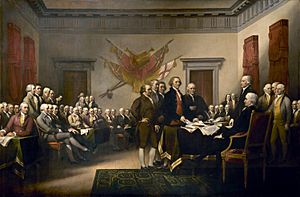
After the French and Indian War, colonists felt they were not being treated fairly by the English government. This was mainly because Britain made the colonies pay new taxes to cover war costs. Americans protested with the cry "No taxation without representation." This meant they believed they should not pay taxes unless they had a vote in the British Parliament. Each new tax caused more anger and brought the colonies closer together. In 1770, colonists in Boston, known as the Sons of Liberty, clashed with British soldiers. This event became known as the Boston Massacre. After the Tea Act, the Sons of Liberty dumped hundreds of boxes of tea into the sea. This was called the Boston Tea Party (1773). In response, the British Army took control of Boston. After that, leaders from the 13 colonies formed a group called the Continental Congress. Important members included Benjamin Franklin, John Adams, Thomas Jefferson, John Hancock, Roger Sherman, and John Jay.
In 1776, Thomas Paine wrote a pamphlet called Common Sense. It argued that the colonies should be free from English rule. This idea was based on English thinkers like John Locke, who wrote about natural rights and the social contract. On July 4, 1776, representatives from the 13 colonies agreed to the United States Declaration of Independence. This document declared them free and independent states, no longer part of England. The colonists were already fighting Britain in the Revolutionary War, which began in 1775 at Lexington and Concord. Although American soldiers under George Washington lost many battles, they won a major victory at Saratoga in 1777. This led to France and Spain joining the war to help the Americans. In 1781, an American victory at Yorktown, aided by the French, convinced Britain to stop fighting and give up the colonies. America had won its independence.
The Early Republic: Building a Nation (1781–1815)
In 1781, the colonies formed a loose group of states under the Articles of Confederation. This system lasted only six years. It gave most power to the states and very little to the central government. The confederation had no president. It struggled to deal with Native Americans or the British on the frontier. It also could not stop local uprisings like Shays' Rebellion. After this rebellion, many people realized the Articles of Confederation were not working well.
In 1787, a new Constitution was written. Many of the people who helped write it, like Washington, James Madison, Alexander Hamilton, and Gouverneur Morris, were leading thinkers of the time. Some of these men later held important government jobs. The Constitution created a stronger national government with three parts: the executive (the President and their staff), the legislative (the House of Representatives and the Senate), and the judicial (the federal courts).
Some states quickly agreed to the Constitution. In other states, many people did not like it because it gave more power to the central government and did not include a bill of rights. To convince people to support the Constitution, Madison, Hamilton, and Jay wrote newspaper articles called the Federalist Papers. Soon after, the Bill of Rights was added. This was a set of 10 amendments (changes) that limited the government's power and protected the rights of citizens. Like the Declaration of Independence, the Constitution is a social contract between the people and the government. The main idea is that the government is a republic, elected by the people, who all have the same rights. However, at first, only white men who owned property could vote. Today, because of state laws and several amendments, almost all American citizens aged 18 or older can vote.
In 1789, Washington was elected the first President. He set an example for how a president should act and retired after two terms. During his time, there was a Whiskey Rebellion, where farmers tried to stop the government from collecting taxes on whiskey. In 1795, Congress passed the Jay Treaty, which increased trade with Britain. In return, the British gave up their forts on the Great Lakes. However, Great Britain continued to harm the U.S. by forcing American sailors to join the British Royal Navy.
John Adams became the second President in 1796, defeating Thomas Jefferson. This was the first American election between two political parties. As president, Adams made the army and navy larger. He also signed the Alien and Sedition Acts, which were very unpopular.
In the 1800 election, Jefferson defeated Adams. One of his most important actions as President was the Louisiana Purchase from France. This deal doubled the size of the United States. Jefferson sent Lewis and Clark to explore and map the new territory. Jefferson also tried to stop trade with England and France to avoid getting involved in the wars they were fighting. However, fighting broke out between the United States and England in 1812 when James Madison was President. This conflict was called the War of 1812.
Growth and Change: Expansion, Industry, and Slavery (1815–1861)
One of the biggest problems during this period was slavery. By 1861, over three million African-Americans were enslaved in the South. This meant they worked for others without freedom or pay. Most worked on large plantations, picking cotton. Cotton became the main crop in the South after Eli Whitney invented the cotton gin in 1793. There were a few slave rebellions, including one led by Nat Turner, but all failed. The South wanted to keep slavery, but by the Civil War, many in the North wanted to end it. Another disagreement between North and South was about the role of government. The South wanted stronger state governments, while the North wanted a stronger central government.
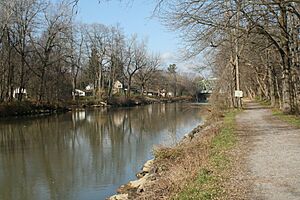
After the War of 1812, the Federalist Party disappeared. This led to an "Era of Good Feelings" with only one major party, under Presidents James Madison and James Monroe. Under Monroe, the United States' policy in North America was the Monroe Doctrine. This policy warned Europe to stop trying to control the U.S. and other independent countries in the Americas. Around this time, Congress supported the "American System." This meant spending money on banking, transportation, and communication. Because of this system, bigger cities and more factories were built. A major transportation project was the Erie Canal in New York. By the 1840s, railroads were also being built. By 1860, thousands of miles of railroads and telegraph lines had been built, mostly in the Northeast and Midwest.
In the early 1800s, the Industrial Revolution came to America. Many factories were built in Northern cities like Lowell, Massachusetts. Most of them made clothes. Many factory workers were women, and some were children or immigrants from Ireland or Germany. Despite this growth in industry, America was still mostly a nation of farmers.
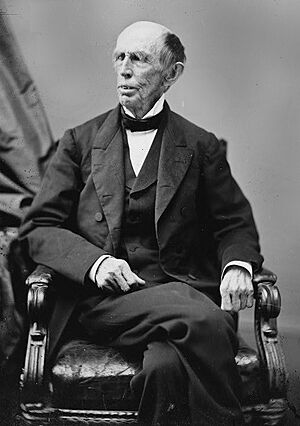
In the early and mid-1800s, a religious movement called the Second Great Awakening took place. Thousands of people gathered at large religious meetings called revivals. They believed they could bring about a better society through religion. New religious groups like the Holiness Movement and the Mormons started, and groups like the Methodist Church grew. The Second Great Awakening led to two major reform movements. One was abolitionism, which aimed to end slavery. People like Harriet Beecher Stowe and William Lloyd Garrison wrote books and newspapers arguing against slavery. They also formed political groups like the Liberty Party, the Free Soil Party, and the Republican Party. Some abolitionists, such as Frederick Douglass, were formerly enslaved people. By 1820, slavery was rare in the North but continued in the South.
In the 1800s, many American women were expected to follow the “cult of domesticity.” This meant most married women were expected to stay home and raise children. Like in other countries, American wives were largely controlled by their husbands and had few rights. Unmarried women had limited job options, such as working in clothing factories or as maids. By the 1800s, women like Lucretia Mott and Elizabeth Cady Stanton believed women should have more rights. In 1848, many of these women met and agreed to fight for more rights, including voting. Many women involved in the women’s rights movement also worked to end slavery.
In 1828, Andrew Jackson was elected President. He was the first president from the Democratic Party. He changed the government in many ways. Since many of his supporters were poor people who had not voted before, he rewarded them with government jobs. This practice is called "spoils" or "patronage." Because of Jackson, a new party called the Whigs was formed to oppose him. This was known as the "Second Party System." Jackson strongly opposed the National Bank, seeing it as a symbol of the Whigs and powerful businessmen. Jackson also supported a high import tax that the South disliked, calling it the "Tariff of Abominations." Jackson’s Vice-President, John C. Calhoun, from the South, wrote that the South should reject the tariff and perhaps leave the Union (secession). These ideas would be used again during the Civil War.
People began moving west of the Mississippi River and the Rocky Mountains during this time. The first people to move west were fur traders like John Colter and Jim Bridger. By the 1840s, many people were moving to Oregon by wagon. Even more people went west after the California Gold Rush of 1849. Many new states were added to the original thirteen, mostly in the Midwest and South before the Civil War, and in the West after the Civil War. During this period, Native Americans lost much of their land. They lost battles to the Americans at Tippecanoe and in the Seminole War. In the 1830s, Native Americans were forced out of the Midwest and South by events like the Trail of Tears and the Black Hawk War. By the 1840s, most Native Americans had been moved west of the Mississippi River.
The Mexican-American War
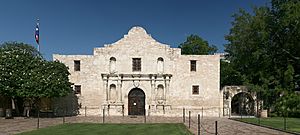
In 1845, Texas, which had been an independent nation after leaving Mexico, joined the United States. Mexico did not like this. Americans also wanted the land Mexico held on the West Coast, a belief known as “Manifest Destiny.” This led to the Mexican–American War. During the war, the U.S. captured cities like San Francisco, Los Angeles, Monterrey, Veracruz, and Mexico City. As a result of the war, the U.S. gained land in California and much of the American Southwest. Many people in the North disliked this war, believing it only benefited Southern slave states.
Civil War: A Nation Divided
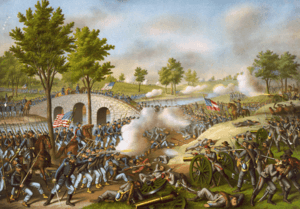
In the 1840s and 1850s, people in the Northern states and Southern states strongly disagreed about whether slavery should be allowed in new territories. Government leaders tried to make deals to prevent war, like the Compromise of 1850 and the Kansas-Nebraska Act. But these deals did not truly keep the Union together. People in the South were angry about books like Uncle Tom's Cabin that said slavery was wrong. People in the North disliked a Supreme Court decision called Dred Scott that kept Scott enslaved. In Kansas, people from the North and South began killing each other over slavery. This was called "Bleeding Kansas." One person from this conflict, John Brown, took over a town in Virginia in 1859 to protest slavery and encourage enslaved people to fight for their freedom.
In the 1860 election, the Democratic Party split. The Republican candidate, Abraham Lincoln, was elected President. After this, many Southern states left the Union. Eventually, eleven states left. They tried to start a new country called the Confederate States of America, or the "Confederacy." A war began between the Union (North) and the Confederacy (South). The South struggled to get guns or uniforms because they lacked factories. Northern ships also blockaded the Southern coast, preventing supplies from reaching them.
Early in the war, Confederate generals like Robert E. Lee and Stonewall Jackson won battles against Union generals such as George B. McClellan and Ambrose Burnside. In 1862 and 1863, the Union Army tried to capture the Confederate capital of Richmond, Virginia several times but failed. Lee's army invaded the North twice but was stopped at Antietam and Gettysburg. In the middle of the war, Lincoln issued the Emancipation Proclamation, which freed all enslaved people in the Confederacy. He also began allowing black men to fight in the Union Army. The war started to turn in the Union’s favor after the battles of Gettysburg and Vicksburg in 1863. Gettysburg stopped Lee from invading the North, and Vicksburg gave the Union control over the Mississippi River. In 1864, a Union Army led by William Tecumseh Sherman marched through Georgia, destroying much of it. By 1865, Union General Ulysses S. Grant had taken Richmond and forced Lee to surrender at Appomattox.
Reconstruction and the Gilded Age: Rebuilding and Riches
In April 1865, Lincoln was killed while watching a play. The new president, Andrew Johnson, oversaw the process of reconstruction. This was about putting the United States back together after the Civil War. During this time, the 13th, 14th, and 15th Amendments to the Constitution were passed. These amendments freed enslaved people, made them citizens, and allowed them to vote. Congress was controlled by "Radical Republicans," who wanted to punish the South after the war. They disliked Johnson and almost removed him from office. They also sent soldiers to the South, put in place unpopular governments, and made the South pass the 14th and 15th Amendments. The South disliked this and created "Jim Crow" laws that limited the rights of black people. White Southerners started a group called the Ku Klux Klan that attacked black people and tried to stop them from voting.
During this time, many people immigrated to the United States from countries like Ireland, Italy, Germany, Eastern Europe, and China. Many worked in large factories and lived in big cities like New York City, Chicago, and Boston. They often lived in small, poor, crowded apartments called "tenements" or "slums." These immigrants were sometimes used by "political machines," who gave them jobs and money in exchange for votes.
Important politicians were often chosen by political machines and were sometimes corrupt. The government had limited power, and leaders of big businesses often had more influence than the government. During this period, there were several very large businesses called trusts. People who ran these trusts made millions of dollars while paying their workers low wages. Some of these powerful business leaders included John D. Rockefeller, Andrew Carnegie, and J. P. Morgan.
After the Civil War, people continued to move west, and new states were formed. People could get free land in the West due to an 1862 law called the Homestead Act. Most of the land in the West was owned by the government, railroads, or large farmers. The Transcontinental Railroad, completed in 1869, helped move people and goods between the West and the rest of the country. Chicago became a major trade center because many rail lines met there. As more people moved west, there were conflicts between white settlers and Native Americans. Many Native Americans were killed in battles like Wounded Knee. Almost all Native American land was taken away by laws like the Dawes Act.
Many Americans felt that railroads charged farmers too much money, making them poor. Workers organized several strikes against the railroads, which the army put down. Farmers also formed groups to fight the railroads, such as the Grange. These groups grew into the Populist Movement, which almost won the presidency with William Jennings Bryan. The Populists wanted reforms like an income tax and direct election of Senators. The Populist Party faded after 1896, but many of their ideas would later become law during the Progressive Era.
Progressive Era and Imperialism: Change and Global Reach
In the United States, progressivism was the belief that the government should play a bigger role in the economy to improve living standards, especially for workers. Imperialism was the belief that the U.S. should build a stronger navy and gain control of lands outside its borders.
In the late 1800s and early 1900s, the U.S. became more involved in foreign affairs. In 1898, the United States fought a war with Spain called the Spanish–American War. The United States won and gained Puerto Rico, Guam, Guantanamo, and the Philippines. Along with buying Alaska and taking over Hawaii, the United States gained all the territory it has today, plus some it would later lose. Around this time, the U.S. and European nations opened up trade with China. This happened after they had defeated China in the Opium Wars and the Boxer Rebellion. The U.S. and Europe could trade with China through the Open Door Policy.
In 1901, Theodore Roosevelt became President. He had been a soldier in the Spanish–American War. He promoted a foreign policy known as the "Big Stick." This meant having a large navy and using control over Latin America. Between 1901 and 1930, the United States sent soldiers into Latin American countries several times. While Roosevelt was president, work began on the Panama Canal. This canal linked the Pacific and Atlantic Oceans, making world travel much faster.
During this time, people started to notice the poor conditions in American cities. A group of writers called “muckrakers” wrote books and newspaper articles about issues like the power of big businesses, unclean practices in factories, and the struggles of poor people. Roosevelt and Congress responded with laws like the Pure Food and Drug Act. This law controlled how food was made to ensure it was safe. Another response was "trust-busting," where large businesses were broken up into smaller ones. The biggest business broken up this way was the Standard Oil Company in 1911.
In 1912, Woodrow Wilson became President. He was a Progressive but had different ideas than Roosevelt. He fought against the "triple wall of privilege," which included big business, high taxes, and fees on imported goods. During his time, the Sixteenth and Seventeenth Amendments to the U.S. Constitution were passed. These allowed for a federal income tax and the direct election of U.S. Senators.
World War I: Global Conflict (1914–1918)
The United States initially wanted to stay out of World War I. It aimed to sell weapons to both sides. In 1915, a German submarine sank a ship carrying Americans called the Lusitania. This angered Americans, and Germany stopped attacking passenger ships for a while. In January 1917, Germany started attacking them again. They also sent the Zimmermann Telegram to Mexico, suggesting Mexico invade the U.S. The United States then joined the war against Germany, and it ended a year later. Wilson worked to create an international organization called the League of Nations. The main goal of the League was to prevent future wars. However, the United States did not join because some Americans, called isolationists, rejected the peace treaty. At the end of World War I, a flu pandemic killed millions of people in the U.S. and Europe. After the war, the United States was one of the richest and most powerful nations in the world.
Boom and Bust: The 1920s and Great Depression (1919–1939)
The "Roaring Twenties"
The 1920s were a time of growth and increased wealth in the United States. Many Americans started buying new products like Model T Fords and appliances. Advertising became very important. During this time, many black people moved from the South to large cities like New York City, Chicago, St. Louis, and Los Angeles. They brought jazz music with them, which is why the 1920s are also called the "Jazz Age." The 1920s were also the Prohibition Era after the Eighteenth Amendment was passed, which banned alcohol.
Racism was still strong in the 1920s. The Ku Klux Klan became powerful again. They attacked black people, Catholics, Jews, and immigrants. Some people blamed war and economic problems on immigrants and labor leaders, calling them Bolsheviks (Russian communists). Many also felt that the United States had lost its religious values. They responded by changing religious practices and sometimes by attacking science.
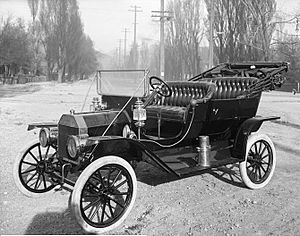
After World War I, the United States followed an isolationist foreign policy. This meant it wanted to avoid another global war. It passed laws and treaties that were supposed to end war forever. It also refused to sell weapons to its former allies.
In 1921, Warren G. Harding became President. He believed that the best way to improve the economy was for the government to support big businesses. This meant cutting taxes and regulating them less. While the economy did well under these policies, America saw the largest gap between the rich and the poor. Harding's presidency had some problems, the biggest being the Teapot Dome scandal over oil drilling in a Navy oil reserve. Harding died in 1923, and Calvin Coolidge became President. Coolidge, like Harding, believed the government should stay out of business and continued many of Harding's policies. Coolidge chose not to run for president in 1928, and Herbert Hoover became president.
The Great Depression
In 1929, a Great Depression hit the United States. The stock market crashed, losing much of its value. Many banks ran out of money and closed. By 1932, over a quarter of the nation had no jobs, and many people were poor or unemployed. Many farmers were forced off their land, not just because of the Depression, but also due to a severe drought and dust storms known as the "Dust Bowl." Farmers had already been struggling in the 1920s.
President Hoover tried to fix the Depression, but his efforts did not work. In 1932, he was defeated, and Franklin D. Roosevelt became President. Roosevelt created the New Deal. This was a series of government programs designed to provide relief (help for those suffering), recovery (to improve the economy), and reform (to prevent another depression).
The New Deal included many programs like Social Security, the National Recovery Administration (which set wages), the Works Progress Administration (which built thousands of roads, schools, and government buildings), the Civilian Conservation Corps (which gave young people jobs helping the environment), and the Tennessee Valley Authority (which built dams and electric lines in the South). These programs put millions of Americans to work, though often with low pay. Many programs started early in Roosevelt's term during a period called the "Hundred Days," or in 1935 during the "Second New Deal." Programs like Social Security grew from populist movements led by people like Huey Long. The New Deal also led to the growth of workers' unions like the Congress of Industrial Organizations.
The New Deal is often seen as the period that "saved capitalism." It stopped America from becoming a Communist or Fascist state. Although the New Deal improved the economy, it did not fully end the Great Depression. The Great Depression finally ended with World War II.
World War II: A Global Fight (1939–1945)

As World War II began, the United States stated it would not get involved. Most Americans believed the U.S. should remain neutral. Some even thought the U.S. should join the Germans. Eventually, the U.S. did try to help the Allied Powers (Soviet Union, Britain, and France) with the Lend-Lease Act. This act gave the Allies a lot of money and weapons in exchange for using air bases around the world.
On December 7, 1941, Japan attacked Pearl Harbor, a U.S. Naval base in Hawaii. The U.S. was no longer neutral. It declared war on the Axis Powers (Germany, Japan, Italy). The U.S. entering World War II ended the Great Depression because the war created many jobs. While some U.S. battles were air and naval fights with Japan, the U.S. mainly fought in Europe and Africa. The U.S. opened several fronts, including in North Africa and Italy. The U.S. also bombed Germany from airplanes, destroying German cities and factories. On June 6, 1944 (D-Day), American and British forces invaded Normandy. A year later, the Allies had freed France and taken Berlin. In 1945, Roosevelt died, and Harry S. Truman became president. The U.S. decided to drop two atomic bombs on Japan. Japan surrendered soon after, and the war ended.
The war brought changes for women and minorities. Many women worked in weapons factories during the war. They were symbolized by a character called "Rosie the Riveter." Many African-Americans served in the army, but often in segregated units with white officers. Japanese-Americans on the West Coast were forced to live in internment camps, though some also served in the Army.
Postwar Era: Cold War and Social Change (1945–1991)
The Cold War
After World War II, the Soviet Union and the United States were the two most powerful countries. The Cold War was a time of tension between them over different ways of life. The two countries tried to get other nations to join their side. The Soviet Union tried to spread Communism, and the United States tried to stop it. American and Soviet soldiers never fought directly, but they fought indirectly in the Korean War (1950s) and the Vietnam War (1950s–1970s).
The Korean War lasted only a few years, but American soldiers have remained in Korea since then. The Vietnam War lasted much longer. It began with a few American troops, but by the 1960s, thousands of Americans were sent to Vietnam. Both wars were between a Northern Communist government, helped by the Soviet Union and Communist China, and a Southern government, helped by the U.S. The Korean War resulted in a divided Korea. However, the Vietnam War ended with a Communist Vietnam after the United States left due to American public desire to end the war. Over a quarter million Americans died or were wounded in Vietnam, which was seen as a military failure. The U.S. and Soviet Union argued about where they could place nuclear weapons. One such argument was the Cuban Missile Crisis. During this crisis, the U.S. and Soviet Union came very close to using nuclear weapons against each other.
During the Cold War, the United States experienced a "Red Scare." The government tried to find people it believed were Communist. The House of Representatives had a group called the House Un-American Activities Committee to deal with this. Joseph McCarthy led similar hearings in the Senate. The Red Scare caused people to lose jobs, go to jail, and some were even executed. Many actors and authors were put on blacklists, meaning they could not get jobs in movies or credit for their writings.
The Cold War began with an arms race between the United States and the Soviet Union. Both wanted to have more and better weapons. This started after the Soviets developed an atomic bomb, becoming the second country to do so. In the United States, this led to something called the "Military Industrial Complex." This meant businesses and the government worked together to spend a lot of money on large-scale weapons projects. This cooperation helped both businesses and the government gain more money and power. Part of this complex was the Marshall Plan, which rebuilt Europe while encouraging them to buy American goods. The Complex helped create a growing middle class but also kept the Cold War going.
Besides the arms race, another part of the Cold War was the "Space Race." This began when the Soviets launched a satellite called Sputnik into space in 1957. Americans worried that the United States was falling behind the Soviet Union. Schools then focused more on mathematics and science. Within a few years, both the U.S. and the Soviet Union had sent satellites, animals, and people into orbit. In 1969, the Apollo 11 mission put Neil Armstrong and Buzz Aldrin on the Moon.
United States foreign policy changed in the 1970s when the U.S. left Vietnam. Richard Nixon also left office due to a political scandal called Watergate. In the 1970s and 1980s, the United States had a policy of "detente" with the Soviet Union. This meant the two countries signed treaties to limit weapons. Under Nixon and Reagan, the United States sent troops and money to many Latin American governments to stop them from becoming Communist. This led to violence in Latin America. Around this time, the economy suffered because the U.S. was not making as many things as it used to. Also, some countries in the Middle East reduced oil supplies to the U.S. (an "oil embargo"). The Middle East became very important in American foreign policy after several Americans were kidnapped in Iran in 1979. In the 1980s, people in the U.S. government sold weapons to people in Iran and gave the money to "contra" soldiers in Nicaragua. This was called the "Iran–Contra affair." In the 1970s and 1980s, the U.S. also improved relations with China. The Cold War ended as Communist governments in the Soviet Union and other countries collapsed.
Domestic and Social Issues
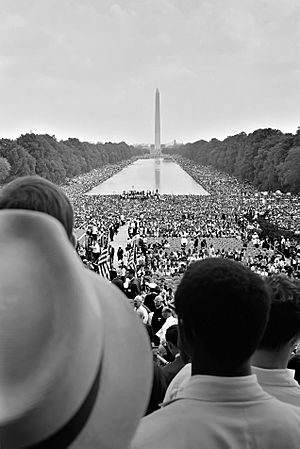
The United States once again experienced prosperity. Millions of white people moved out of cities and into suburbs. They also moved to Southern and Western states known as the "Sunbelt." They bought new cars and television sets. The birth rate in the 1940s and 1950s rose, in what was called the "Baby Boom." The "Space Age" inspired "Googie" style art and architecture. Many more people became part of the middle class, but many people were still poor.
Poverty was most common among African-Americans. Most lived in poor neighborhoods in Northern cities or in the South, where they faced racism and "Jim Crow" segregation. These conditions led to the Civil Rights Movement of the 1950s, led by Martin Luther King Jr. and others. In 1954, the Supreme Court ruled that school segregation was illegal in Brown v. Board of Education. However, it took several years for school segregation to end. In 1955, King led a bus boycott in Montgomery, Alabama. In the late 1950s and 1960s, King received support from Presidents John F. Kennedy, who was shot, and Lyndon B. Johnson. In 1963, King led a march on Washington calling for civil rights. Soon after, Congress passed laws that made most segregation illegal. Johnson also passed a program called the Great Society that helped poor people and minorities.
Gays and lesbians, who had often been treated unfairly, also began to ask for rights. This movement started with the Stonewall riots in 1969. Chicanos, Native Americans, older people, consumers, and people with disabilities also fought for their rights, as did women. Although women had jobs during World War II, most returned home after the war. Women disliked that they often held jobs that paid less than men or had fewer opportunities. People like Betty Friedan and Gloria Steinem founded groups such as the National Organization for Women to address these problems. NOW and other groups wanted an Equal Rights Amendment that would guarantee women equality in all areas. In the 1970s and 1980s, many more jobs and opportunities opened up for women. Some women, like Phyllis Schlafly, opposed Freidan and Steinem and were known as "anti-feminists." The Equal Rights Amendment was defeated partly because of the anti-feminists, but also because women had already gained equality in many areas and did not want to be drafted into the army.
In the 1960s, the counterculture emerged. Some followers of the counterculture were called hippies. They had long hair and lived communally. The counterculture, along with college students, were the groups most against the Vietnam War. They also listened to new music known as rock and roll.
The Reagan Era
Ronald Reagan was elected President in 1980. He won by a large margin, taking 44 out of 50 American states, defeating the current president, Jimmy Carter. During the Reagan Era, the country faced inflation, a struggling economy, and challenges in American foreign policy. When Ronald Reagan became president, he signed the Economic Recovery Tax Act of 1981. This law lowered taxes for businesses, hoping they would reinvest their extra profits back into the economy. During Reagan's presidency, he expanded the American military, creating more jobs. However, this also increased the national debt due to high spending. In his first term, the economy improved.
In 1984, Reagan won by an even larger margin, taking 49 out of 50 American states. During his second term, Reagan focused on ending the Cold War. He held many meetings with leaders like Margaret Thatcher, Pope John Paul II, and Soviet leader Mikhail Gorbachev. They first met at the Geneva Summit in 1985. They both shared a desire to end the Cold War. Reagan met four times with Soviet leader Mikhail Gorbachev, who came to power in 1985. Their meetings led to the signing of the Intermediate-Range Nuclear Forces Treaty.
Also during his second term, Reagan's invasion of Grenada and bombing of Libya were popular in the U.S. However, his support for the Contras rebels faced controversy due to the Iran–Contra affair. This event showed some problems with Reagan's management style.
Since leaving office in 1989, Reagan has become one of the most popular Presidents of the United States.
Modern America: Post-Cold War and Beyond (1991–Present)
The Post-Cold War Era
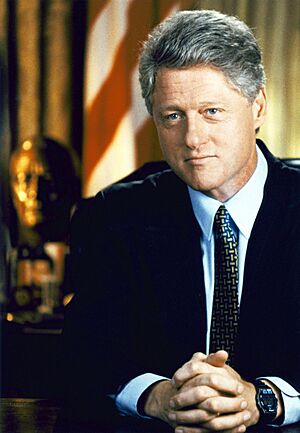
In the late 1980s and early 1990s, the Cold War ended. This happened because the Russian leader Mikhail Gorbachev started a policy called perestroika, the Berlin Wall fell, and the Soviet Union broke into different countries. Around this time, the United States reduced its production of cheap goods. Many people started working in service jobs. Some of these service jobs were in computers and the internet, which became widely used in the 1990s. By this time, the United States had a very large trade deficit. This meant it bought more goods from other countries, like China, than it sold to them.
The Middle East became the main focus of U.S. foreign policy. In 1991, the United States fought a war with Iraq called the First Gulf War or Operation Desert Storm. This war aimed to stop Iraqi leader Saddam Hussein from taking over Kuwait, a small oil-producing country.
In 1992, Bill Clinton became President. Under Clinton, the United States sent soldiers into Bosnia as part of a United Nations mission. The United States also agreed to a trade agreement called the North American Free Trade Agreement. Clinton was accused of wrongdoing for lying in court about a personal relationship. However, the Senate voted against removing him as President.
The 21st Century
The Bush Presidency
In 2000, George W. Bush was elected President. Terrorists attacked the World Trade Center on September 11, 2001. Thousands of people died. Soon after the attacks, the U.S. and NATO went to Afghanistan. They aimed to find Osama bin Laden and others believed to have planned the September 11 attacks. In 2003, the United States invaded Iraq. The wars in Iraq and Afghanistan lasted many years. By 2011, most American soldiers had left Iraq, and combat there was over.
In 2005, Hurricane Katrina hit the southern United States. Much of the city of New Orleans was destroyed. In 2006, the Democrats regained control of Congress. Americans were unhappy with how Bush handled the War in Iraq and Hurricane Katrina. At the end of Bush's term, the United States entered the worst recession since the Great Depression.
The Obama Presidency
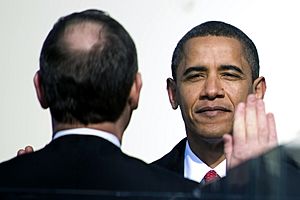
Barack Obama was elected President in 2008. He became the first African-American President of the United States. During his first years, Obama and Congress passed reforms on health care and banking. They also passed a large stimulus bill to help the economy during the recession. During the recession, the government used large amounts of money to prevent the banking and auto industries from collapsing. There was also a large oil spill in the Gulf of Mexico. In 2010, Congress passed the Patient Protection and Affordable Care Act, a major change to the health care system. Called "Obamacare," it faced strong criticism from conservative media.
A "Tea Party movement" started during Obama's presidency. This group opposed Obama's health care plan and other policies they saw as "big government." Because of the recession, the Tea Party, and dislike for some of Obama's actions, Republicans won many House and Senate seats in the 2010 election. In 2011, Tea Party members in Congress almost shut down the government and nearly caused the U.S. to default on its debts. A few months later, many young people protested against concentrated wealth during the Occupy movement. In 2012, Obama was reelected for a second term. After his reelection, Obama faced major opposition from Congressional Republicans. This political division led to events like the 2013 Federal Government Shutdown and the delay in approving Obama's Supreme Court choice, Judge Merrick Garland. In 2014, Republicans gained control of both houses of Congress, increasing political gridlock. In foreign policy, President Obama helped create the Paris Climate Agreement, a major global effort to fight climate change. He also made the Iran Nuclear Agreement and opened relations with Cuba for the first time in fifty years.
The Trump Presidency
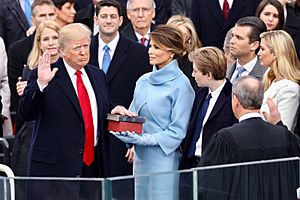

The 2016 United States presidential election gained much attention. The main popular candidates were Republicans Donald Trump and Senator Ted Cruz, and Democrats Hillary Clinton and Senator Bernie Sanders. Trump and Clinton won their party's primary elections. On November 9, 2016, Trump defeated Clinton. Trump was inaugurated on January 20, 2017. Afterward, many protests against Trump took place across the country.
On January 27, President Trump signed an executive order. It stopped refugees from entering the country for 120 days. It also denied entry to citizens from Iraq, Iran, Libya, Somalia, Sudan, Syria, and Yemen for 90 days. The order cited security concerns about terrorism. The next day, thousands of protesters gathered at airports and other places across the United States. They protested the order and the detention of foreign nationals. Later, the administration seemed to change part of the order, allowing visitors with a green card to enter.
On May 3, 2017, Puerto Rico declared bankruptcy due to massive debt and a weak economy. It was the largest bankruptcy case in American history.
On September 24, 2019, Speaker of the House Nancy Pelosi announced that the House of Representatives would begin an impeachment inquiry into Trump. On October 31, 2019, the House voted to create procedures for public hearings. On December 16, the House Judiciary Committee released a report detailing charges related to abuse of power. The House voted to impeach Trump on December 18, 2019. This made him the third president in American history to be impeached.
During most of 2020, the United States was affected by the COVID-19 pandemic, which impacted the entire world. The country had the highest number of infections and deaths from the virus. The Trump administration received negative feedback for its handling of the virus. Some people refused to wear surgical masks to help stop the virus's spread. In some states, governors ordered lockdowns to try to stop the virus from spreading.
Starting in May 2020, racial tensions in the country grew stronger. The Black Lives Matter movement gained popularity, though it received mixed reactions.
On November 7, 2020, former Vice President Joe Biden defeated President Trump in the country's highest voter turnout presidential election. Biden became the oldest person elected to the office and the first from the state of Delaware. Biden's running mate, U.S. Senator Kamala Harris, was the first woman, African-American, and Asian-American to be elected Vice President or any high-ranking elected office in the country.
On January 6, 2021, while members of the United States Congress met to confirm Biden's electoral victory, supporters of President Trump stormed the United States Capitol. They tried to overturn the results of the 2020 election. Four people died.
A Changing Country
The United States faces many political issues. One debate is about what kind of government the U.S. should have. Liberals want a larger government, while the Tea Party and other groups want a smaller government. One of these debates is about health care, as health care costs have risen. Conservatives and liberals also disagree on social issues like gay marriage. Many more people have come to accept gays and gay marriage as an acceptable part of American society. There are also many trends and changes the U.S. must deal with. One is immigration. Many people are coming to the U.S. from Latin America and Asia, especially Mexico. This is sometimes called the "browning of America." Baby Boomer Americans are getting older, and a larger portion of the population is retired. Other issues facing the United States include a growing concern about the environment. This has led to the creation of many "green jobs," which are jobs that create clean or renewable energy.
Related pages
Images for kids
-
Approximate location of the ice-free corridor and specific Paleoindian sites (Clovis theory)
-
The Cultural areas of pre-Columbian North America, according to Alfred Kroeber
-
Grave Creek Mound, located in Moundsville, West Virginia, is one of the largest conical mounds in the United States. It was built by the Adena culture.
-
Monks Mound of Cahokia (UNESCO World Heritage Site) in summer
-
Cliff Palace, Mesa Verde National Park, a UNESCO World Heritage Site
-
Squanto, known for having been an early liaison between the native populations in Southern New England and the Mayflower settlers
-
The First Thanksgiving at Plymouth, 1914, Pilgrim Hall Museum, Plymouth, Massachusetts
-
John Gadsby Chapman, Baptism of Pocahontas (1840), on display in the Rotunda of the U.S. Capitol
-
The population density in the American Colonies in 1775
-
Washington's surprise crossing of the Delaware River in December 1776 was a major comeback after the loss of New York City; his army defeated the British in two battles and recaptured New Jersey.
-
The United States after the Treaty of Paris (1783), with individual state claims and cessions through 1802
-
George Washington's legacy remains among the greatest in American history, as Commander-in-Chief of the Continental Army, hero of the Revolution, and the first President of the United States (by Gilbert Charles Stuart)
-
Depiction of election-day activities in Philadelphia (by John Lewis Krimmel, 1815)
-
Thomas Jefferson saw himself as a man of the frontier and a scientist; he was keenly interested in expanding and exploring the West.
-
Territorial expansion; Louisiana Purchase in white
-
Oliver Hazard Perry's message to William Henry Harrison after the Battle of Lake Erie began with: "We have met the enemy and they are ours" (by William H. Powell, 1865)
-
A drawing of a Protestant camp meeting (by H. Bridport, c. 1829)
-
Settlers crossing the Plains of Nebraska (by C.C.A. Christensen, 19th century)
-
The Indian Removal Act resulted in the transplantation of several Native American tribes and the Trail of Tears.
-
Horace Greeley's New York Tribune—the leading Whig paper—endorsed Clay for President and Fillmore for Governor, 1844
-
The California Gold Rush news of gold brought some 300,000 people to California from the rest of the United States and abroad.
-
The American occupation of Mexico City in 1848
-
The Battle of Franklin, November 30, 1864
-
Lincoln with Allan Pinkerton and Major General John Alexander McClernand at the Battle of Antietam
-
Freedmen voting in New Orleans, 1867
-
The completion of the Transcontinental Railroad (1869) at First Transcontinental Railroad, by Andrew J. Russell
-
Mulberry Street, along which Manhattan's Little Italy is centered. Lower East Side, circa 1900. Almost 97% of residents of the 10 largest American cities of 1900 were non-Hispanic whites.
-
Charlotte Perkins Gilman (pictured) wrote these articles about feminism for the Atlanta Constitution, published on December 10, 1916.
-
Money supply decreased a lot between Black Tuesday and the Bank Holiday in March 1933 when there were massive bank runs across the United States.
-
Dorothea Lange's Migrant Mother depicts destitute pea pickers in California, centering on Florence Owens Thompson, a mother of seven, age 32, in Nipomo, California, March 1936
-
Brazilian President Getúlio Vargas (left) and U.S. President Franklin D. Roosevelt (right) in 1936
-
The Japanese crippled American naval power with the attack on Pearl Harbor, destroying many battleships.
-
Into the Jaws of Death: The Normandy landings began the Allied march toward Germany from the west.
-
The Trinity test of the Manhattan Project was the first detonation of a nuclear weapon.
-
Cuban Missile Crisis a U-2 reconnaissance photograph of Cuba, showing Soviet nuclear missiles, their transports and tents for fueling and maintenance
-
Buzz Aldrin (shown) and Neil Armstrong became the first people to walk on the Moon during NASA's 1969 Apollo 11 mission
-
Civil Rights leader Martin Luther King Jr. (right) with President Lyndon B. Johnson in the background (left)
-
Duncan West speaking with Cesar Chavez. The Delano UFW rally. Duncan represented the Teamsters who were supporting the UFW and condemning their IBT leadership for working as thugs against a fellow union.
-
United States Navy F-4 Phantom II shadows a Soviet Tu-95 Bear D aircraft in the early 1970s
-
Richard Nixon departs
-
Ronald Reagan at the Brandenburg Gate challenges Soviet general secretary Mikhail Gorbachev to tear down the Berlin Wall in 1987, shortly before the end of the Cold War.
-
Clinton, Yitzhak Rabin and Yasser Arafat during the Oslo Accords on September 13, 1993
-
The former World Trade Center in Lower Manhattan during September 11 attacks in 2001
-
George W. Bush addressed the General Assembly of the United Nations on September 12, 2002, to outline the complaints of the United States government against the Iraqi government.
-
Tea Party protesters walk towards the United States Capitol during the Taxpayer March on Washington, September 12, 2009
-
Barack Obama was the first African-American president of the United States
-
A naval officer checks on a patient connected to a ventilator in Baton Rouge during the COVID-19 pandemic
-
Supporters of then-President Donald Trump attempted to stop the counting of electoral votes on January 6, 2021.
-
Women surrounded by posters in English and Yiddish supporting Franklin D. Roosevelt, Herbert H. Lehman, and the American Labor Party teach other women how to vote, 1936.
See also
 In Spanish: Historia de los Estados Unidos para niños
In Spanish: Historia de los Estados Unidos para niños


